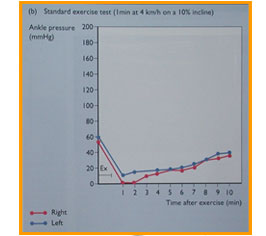Stress Test for Legs
- Home
- Stress Test for Legs
Stress Test for Legs
 Stress Test for legs is extremely useful in predicting the severity of the arterial stenosis and it’s physiological effect on the leg circulation. Normally, after exercise, the blood flow to the limbs (legs) increases to accommodate the increase in demand by the working muscles. This is reflected by a rise in the ABI. When there is reduction in flow due to proximal narrowing or stenosis there is a drop in ABI since the vessels in the muscles dilate to accommodate the increase in demand, in anticipation of the increase in blood flow that does not take place.
Stress Test for legs is extremely useful in predicting the severity of the arterial stenosis and it’s physiological effect on the leg circulation. Normally, after exercise, the blood flow to the limbs (legs) increases to accommodate the increase in demand by the working muscles. This is reflected by a rise in the ABI. When there is reduction in flow due to proximal narrowing or stenosis there is a drop in ABI since the vessels in the muscles dilate to accommodate the increase in demand, in anticipation of the increase in blood flow that does not take place.
 The extent of drop in the ABI (white circle) reflects the severity of the stenosis and the consequent deficit and ischemia it produces. This is a very useful test for early detection of peripheral arterial disease (PAD). The time taken for the ABI to recover to the resting rate (green circle) reflects the extent of the collateral circulation. The distance walked before symptoms start and force the person to stop walking (claudication distance), is another useful parameter to monitor the improvement or deterioration of the patient’s disease.
The extent of drop in the ABI (white circle) reflects the severity of the stenosis and the consequent deficit and ischemia it produces. This is a very useful test for early detection of peripheral arterial disease (PAD). The time taken for the ABI to recover to the resting rate (green circle) reflects the extent of the collateral circulation. The distance walked before symptoms start and force the person to stop walking (claudication distance), is another useful parameter to monitor the improvement or deterioration of the patient’s disease.


